Optimal UVB Lighting Setups for Exotic Reptile Enclosures: 7 Essential Tips
Setting up ideal UVB lighting for your exotic reptiles is key to their health and happiness. First, know your pet’s UVB needs—like, desert lizards crave that 10.0 UVB bulb, while tropical ones are more chill with a 5.0. Don’t forget to position the bulbs just right, ensuring one-third of the enclosure gets that sweet UVB goodness. Regular maintenance is a must too, like cleaning bulbs and monitoring usage. Stick around for more fun tips that’ll make your enclosure shine!
Quick Takeaways
- Choose the right UVB bulb type based on your reptile species; use a 10.0 bulb for desert reptiles and a 5.0 bulb for tropical species.
- Position UVB bulbs directly above basking areas to simulate natural sunlight and ensure one-third of the enclosure receives direct UVB light.
- Incorporate shaded areas and climbing structures to provide a diverse environment for comfort and varying UVB exposure levels.
- Regularly clean and replace UVB bulbs every 6 to 12 months to maintain optimal performance and effective UV output.
- Monitor basking behavior and use UV Index meters to assess and adjust UVB exposure for your reptiles’ health needs.
Understanding Species-Specific UVB Needs

When it comes to understanding species-specific UVB needs for our scaly friends, it’s essential to recall that one size doesn’t fit all – and that’s not just me being dramatic! Did you know desert reptiles soak up intense sunlight, while tropical species need a gentler glow? As someone who loves creating cozy habitats at ExoTails, I can’t stress enough how important it’s to figure out your pet’s unique UVB requirements. Regular exposure to natural sunlight is encouraged to help fulfill these needs!
Selecting the Right UVB Bulb Types
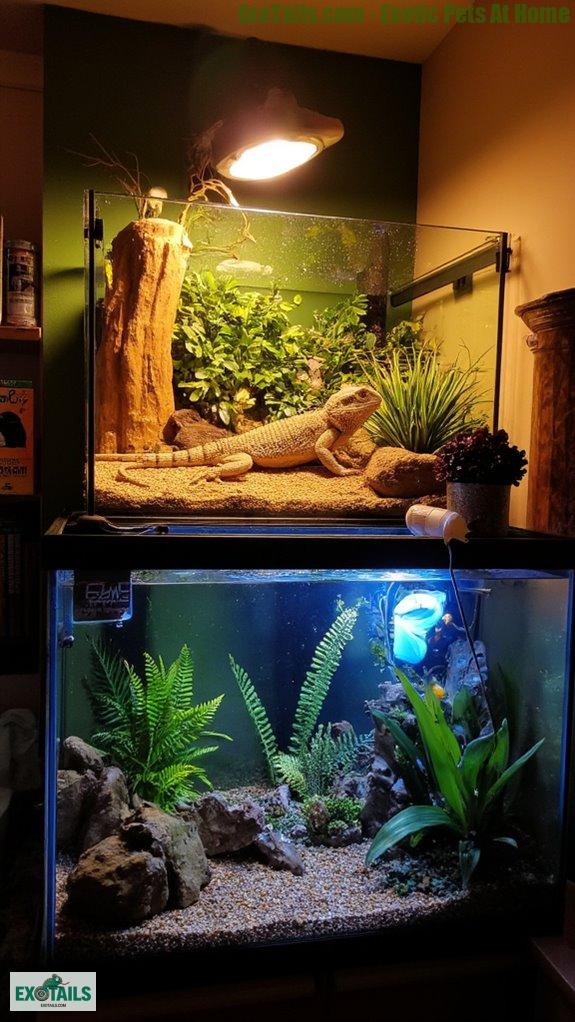
How do you choose the right UVB bulb for your reptile, especially with so many options out there?
First, think about your reptile’s habitat. For desert dwellers like bearded dragons, a 10.0 bulb packs a powerful UV punch, while forest buddies like chameleons do better with a 5.0. Additionally, understanding the specific needs of the reptile will help ensure you select the appropriate bulb.
Compact bulbs are convenient but need replacing every 6 months. I prefer T5 fluorescent tubes—they last longer and provide more UVB.
Just keep in mind, too much UV can be harmful!
At ExoTails, I’ve learned that the right bulb can make all the difference in keeping our scaly friends happy and healthy. Choosing wisely is key!
Designing the Perfect Enclosure for UVB Exposure

Creating the perfect enclosure for your reptile can feel a bit like designing a cozy little apartment for your scaly roommate. You’ll want to position the UVB bulb directly above the basking spot to mimic natural sunlight. The use of small UVB lamps is an excellent option for lower-height habitats, ensuring your reptile receives adequate UVB exposure. Try ensuring at least a third of the enclosure gets direct UVB, but mix it with shaded areas for balance. Consider adding climbing structures so your reptile can choose how much UVB it wants. I’ve learned that proper layout isn’t just fun; it’s essential.
Managing UVB Light Intensity Effectively
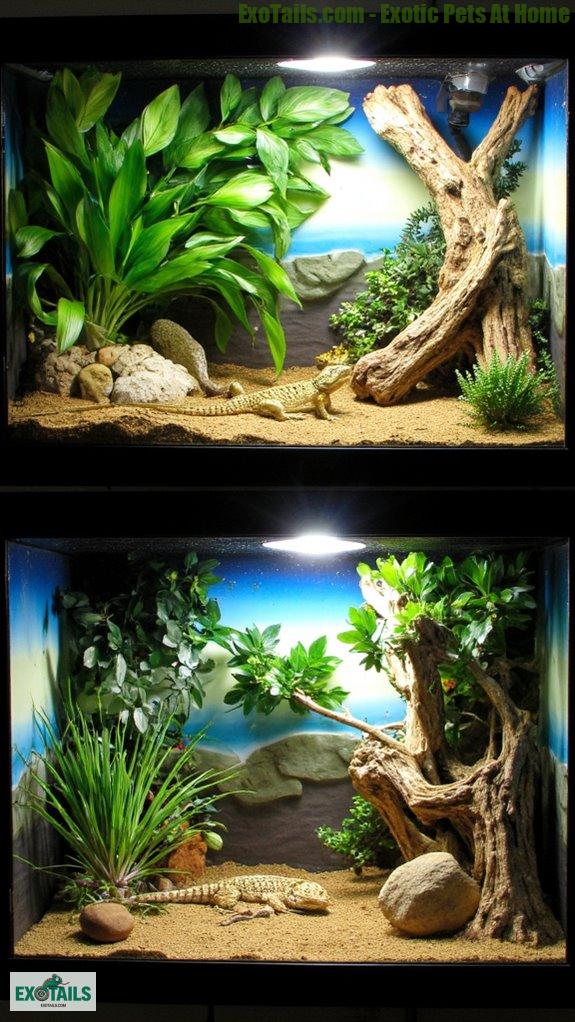
While you may think managing UVB light intensity is just about flipping a switch, there’s actually a bit more to it than that!
You’ve got to reflect on your reptile’s needs. For instance, Crested Geckos prefer lower UVB levels, while bearded dragons crave that sunbeam intensity.
Adjust bulb distance too, as too far means less UVB—think 25% less with every distance double!
Watching your reptiles bask will show you if they’re getting enough. Their health relies on it, trust me.
Terrarium design can also play a significant role in how effectively UVB light is distributed across the enclosure.
I started ExoTails to explore these essential details, ensuring their happy, healthy lives. After all, who doesn’t want a thriving scaly buddy?
Creating a Natural Environment for Your Reptiles
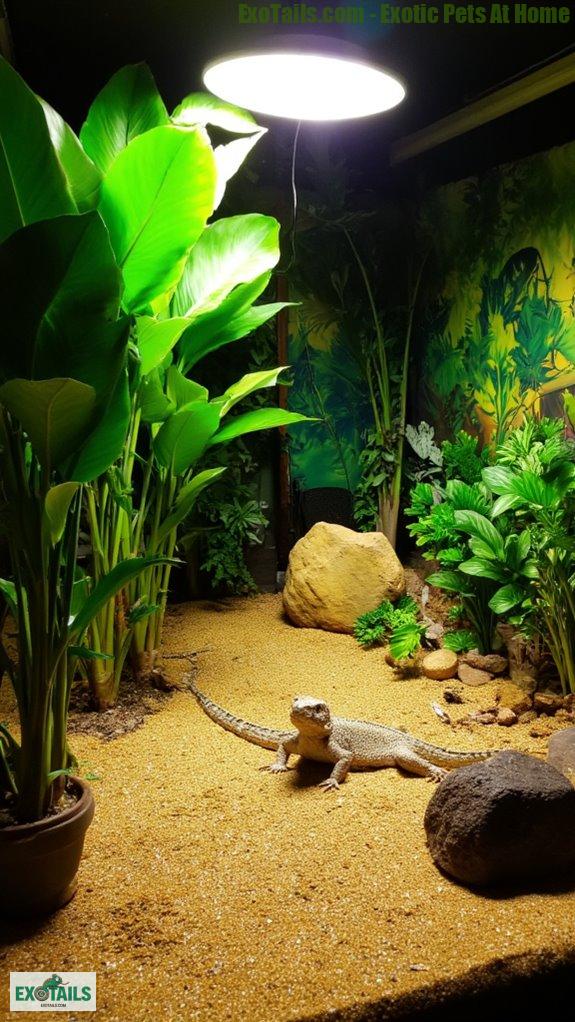
When you think about setting up a home for your reptiles, don’t you want it to feel like their natural habitat? I sure did when I created ExoTails!
By researching the specific ecosystem of your reptile’s ancestors, you can design an enclosure that promotes safety and comfort.
Utilizing substrates that mimic their natural terrains, like sand or coconut fiber, is essential for burrowing creatures. Plus, adding live plants can create much-needed humidity and hiding spots.
These elements nurture a bioactive environment, enhancing their well-being. Creating a cozy tropical terrarium for your reptiles can significantly boost their happiness. Wouldn’t you feel better basking in your own little oasis? Let’s make their home truly exceptional!
Implementing a Regular UVB Maintenance Schedule
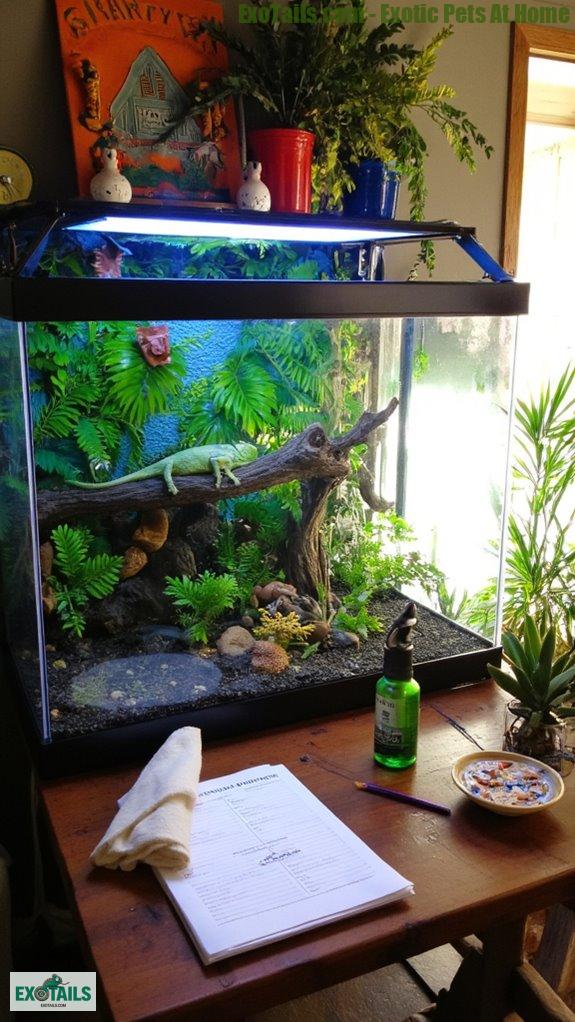
It’s amazing how a little bit of sunlight can make such a huge difference in your reptile’s life, but that sunlight doesn’t exactly come from the sky in your living room!
To keep that essential UVB lighting effective, I recommend cleaning bulbs regularly and replacing them every 6 to 12 months.
Don’t forget to log usage and check for performance changes—after all, nobody wants their scaly buddy suffering just because of a dull bulb!
I created ExoTails to help you guarantee your exotic pets thrive, and I promise, a little maintenance makes a world of difference.
Let’s keep those reptiles happy and healthy!
Monitoring Reptile Health and UVB Lighting Efficiency
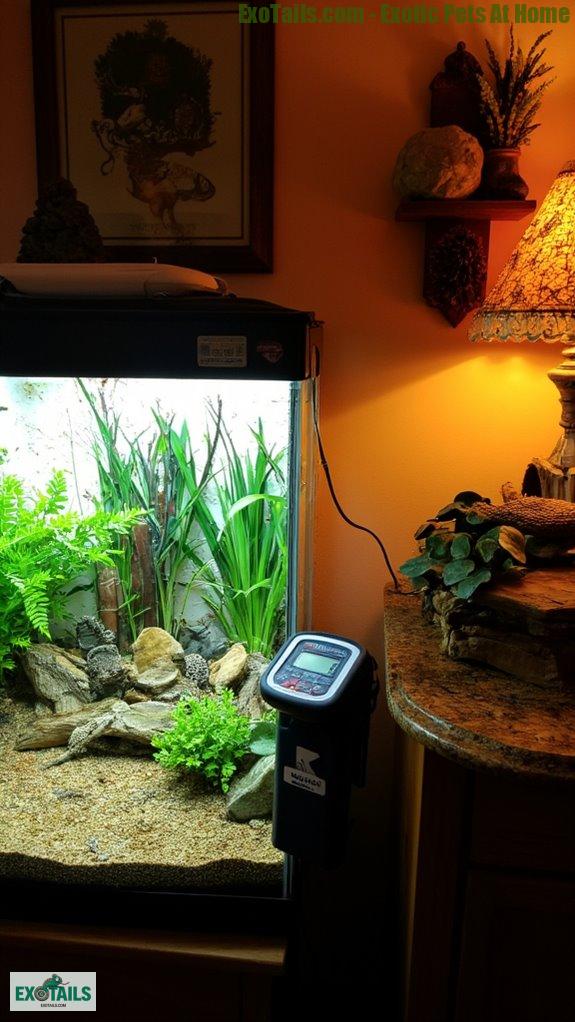
Monitoring your reptile’s health and the efficiency of UVB lighting is essential for ensuring your scaly companion leads a joyful and vibrant life.
Have you noticed your reptile basking more? That’s a good sign!
Keep an eye out for shedding cycles and steady feeding patterns—they indicate your UVB is doing its job.
But if your pet’s acting like a couch potato, it mightn’t be getting enough UVB. Tools like UV Index meters can help, too.
Trust me, I’ve learned that happy reptiles equal a happy home—hence why I started ExoTails!
Let’s keep our critters thriving, shall we?
Designing Functional Activity Areas
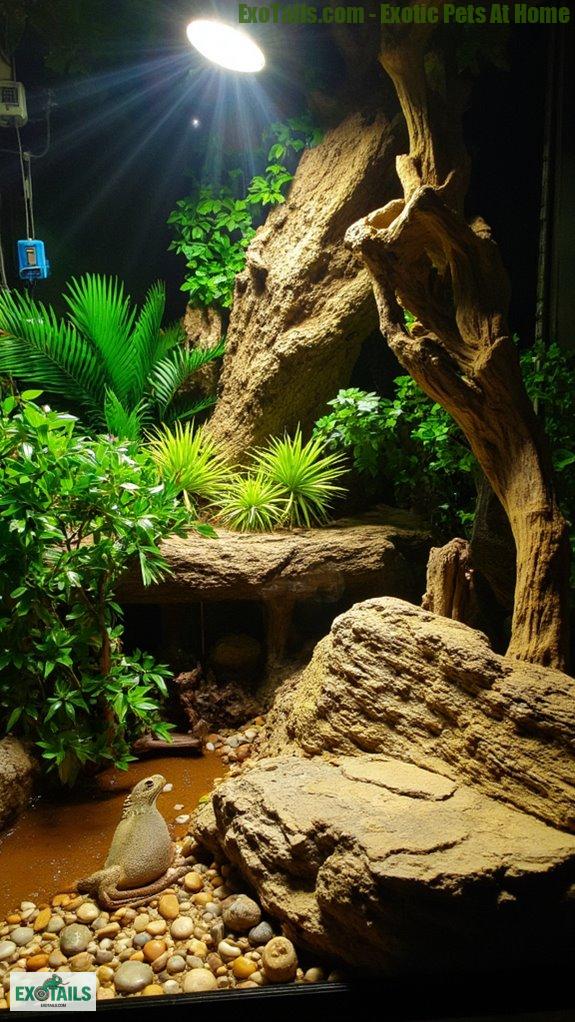
Designing functional activity areas is a crucial part of creating a cozy home for your reptilian friend, wouldn’t you agree? By utilizing vertical and horizontal space, you can incorporate climbing structures and varied terrain to spark their natural instincts.
Visualize your lizard happily basking on a ledge!
Zoning is key—set up separate spots for basking, hiding, and feeding to keep stress levels down. Plus, using non-toxic materials for climbing and hiding spots guarantees safety.
As someone who loves exotic pets just as much as home decor, I’ve always found balancing beauty and function to be a fun challenge—like decorating with a sense of adventure!






